Like any competitive endeavor, operating a business requires a deep understanding of your competition and how you stack up against them. Most business owners and marketers are familiar with the process of conducting market research or competitive analysis. These deep diving processes can generate a tremendous amount of data about the competitive landscape.
But once you have this data on hand, what do you do with it? Ultimately, you’ll need to derive insights, but this work can be difficult with a mess of raw data before you. So, your first step is to organize the data and make it understandable to yourself or to a wider audience.
In this article, we’ll look at the competitive matrix as a tool for organizing, understanding, and generating insights from data about your competitors. We’ll define what a competitive matrix is, offer a few examples of different competitive matrices, and show you how to gather your own data to better understand your target market.
Working Toward a Competitive Matrix Definition
The term “competitive matrix” generally refers to tools that help organize and visualize data about your market competitors. We use the term “generally” because there are many types of competitive matrices that depict a variety of data in various ways.
Some examples of data you can bring to a competitive matrix include:
Social media statistics Web traffic statistics Sales data Product comparisons Marketing and content comparisons Audience demographics Customer reviewsYour competitive matrix will change depending on what data you’re considering, even while looking at the same competitors. For example, a business that takes the lead for web traffic on one matrix may take a vastly different position on a matrix measuring foot traffic for a physical location. And it may take a completely different position when considering social media traffic.
Competitive matrices also come in a variety of shapes and sizes depending on how you want to organize and analyze the data. You might use a SWOT analysis in one case, and a Porter's 5 Forces model in another. For some datasets, a spreadsheet will make the most sense. For another, you might use a competitive positioning matrix or competitor analysis axis, such as the example from G2 in the section titled “The Competitive Analysis Matrix” in the next section.
Generally, a competitive matrix can help you:
Better understand your niche and what makes your business unique Target new markets for your products and services Reveal your competitive advantages and weaknesses Uncover threats or opportunities in your market Understand customer sentiment and satisfaction Identify areas of improvement for your business or marketing strategy Benchmark your business and marketing efforts Develop stronger business plans and marketing plansRegardless of the insights you seek, a clear understanding of your position is the first step to staying competitive. If you don’t know where you stand, what your strengths and weaknesses are, where your threats lie, and how to find opportunity, you’ll never get where you want to go.
Visual Competitor Matrix Examples
Competitor matrices come in a variety of shapes and sizes. The form a matrix takes typically depends on the information you’re attempting to derive from the data.
Below, we offer two kinds of competitive matrices that provide different ways to organize your data once you’ve gathered your competitive intelligence.
The Competitive Analysis Matrix
The competitive analysis matrix, also called a “competition matrix,” are examples of matrices that depict competitors from within a market along an X/Y axis. They provide a clear picture of where businesses exist in the competitive landscape with regard to one another.
Gartner’s “Magic Quadrant” matrix places businesses on their matrix based on metrics they’ve developed called “Ability to execute” and “Completeness of vision.” Companies are placed depending on how they score in these two categories.
 Gartner.com
Gartner.com For example, Microsoft scores high in their ability to execute and the completeness of their vision, which places them in the “Market Leader” quadrant. Salesforce, on the other hand, has a high completeness of vision score, but is not able to fully execute, placing them in the “visionary” category.
G2 Crowd uses customer feedback to place businesses on their matrix. Their metrics are “Market Presence” on the X axis and “Satisfaction” on the Y axis. These metrics allow them to define business as Contenders, Leaders, Niche, or High Performers.
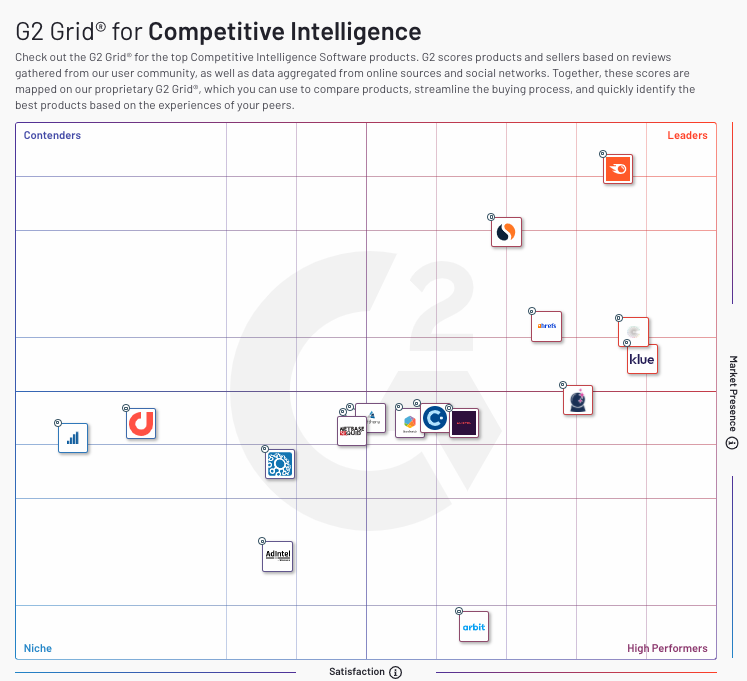 G2.com
G2.com Semrush offers a similar competitive analysis matrix in their Market Explorer tool, but it includes the added benefit of allowing you to see the way businesses’ positions change over time.
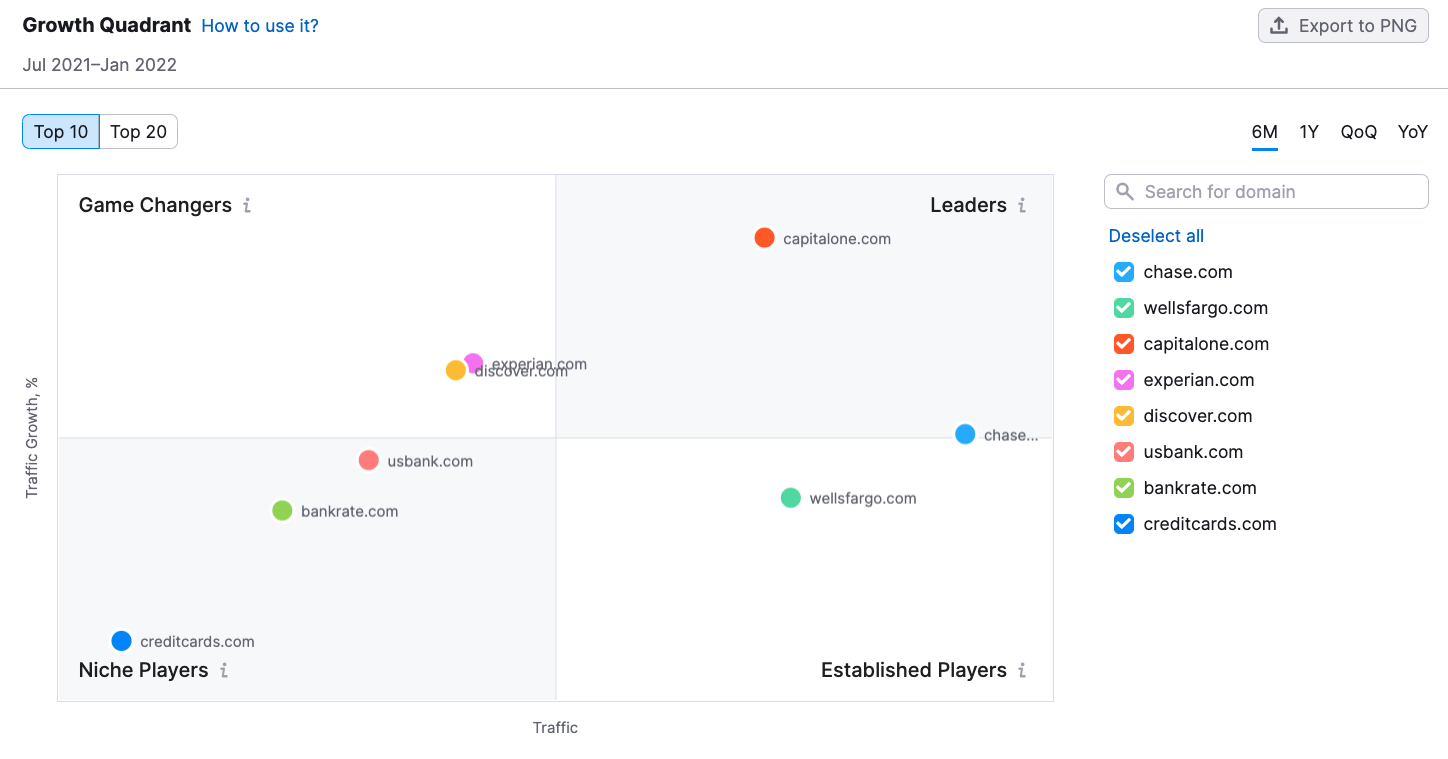
For example, businesses with high traffic growth but lower traffic are considered “game changers.” If that same company begins getting an influx of regular traffic but sees less growth, they will become an “established player.”
As you can see with all of these competitive matrices, the criteria by which businesses are placed on the graph change, but with each one, you gain an understanding of the lay of the business landscape.
The Competitor Comparison Chart
Sometimes, it makes the most sense to view competitor data side by side, as opposed to visually across a matrix. A simple comparison chart allows you to arrange data to easily compare features and benefits while developing competitor profiles.
For example, this comparison chart clearly depicts the distinctions between Semrush and Similarweb software in terms of what features they offer.
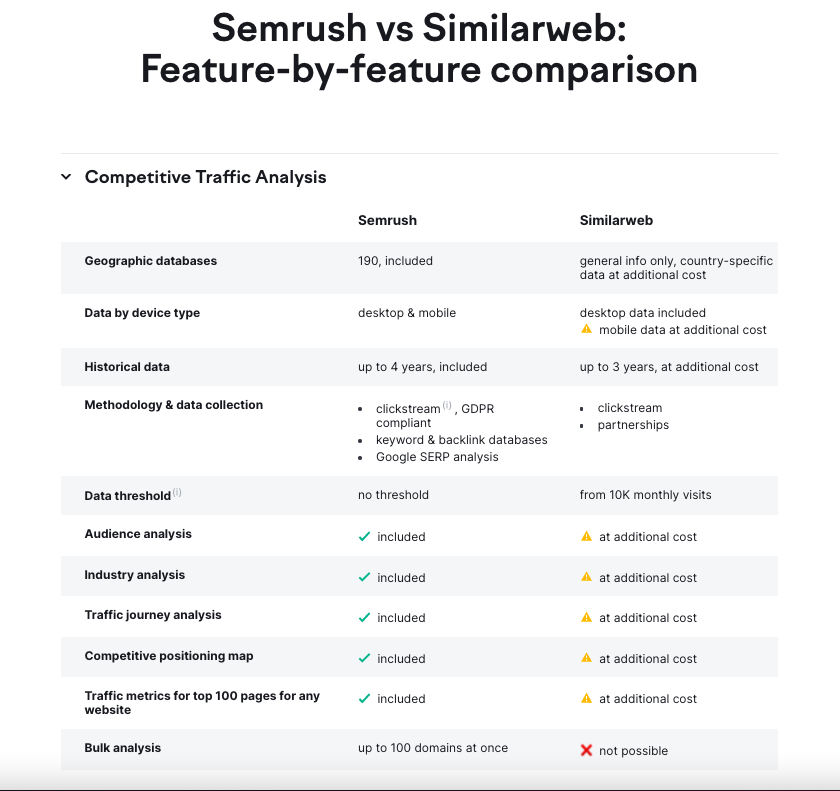
You can add any number of competitors to the chart to create a wider pool of software for comparison. As you can see, comparison charts make it easy to see differences and similarities between two or more competitors.
You can also use a comparison chart to organize information beyond product features. For example, you might want to compare statistics for competitors side by side. In this chart, you could enter organic, paid, and local search statistics for five competitors and compare them side-by-side.
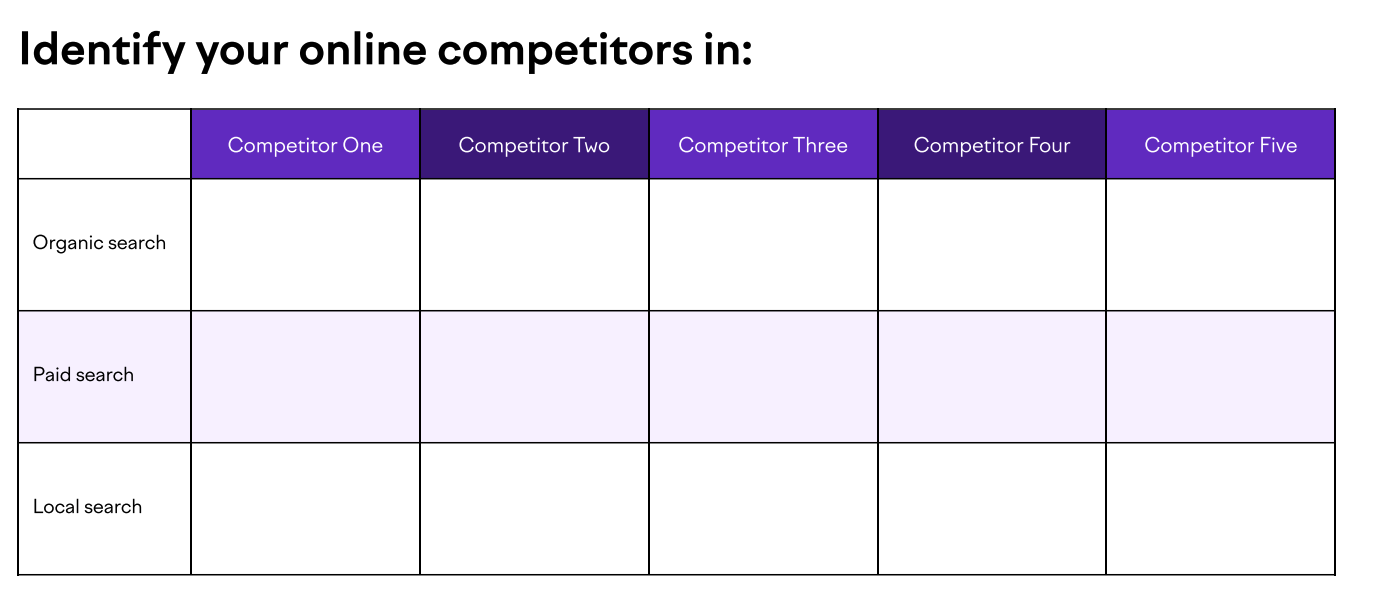
Get your free competitor analysis template as a PDF or .xlsx
Other Possible Matrix Styles
For creative thinking, it can help to visualize data in various ways to find less obvious connections. For this kind of creative organization and brainstorming, there are a variety of tools online that offer matrix templates you can plug data into.
Creately allows you to create charts, flows, diagrams, and mind maps like the one below. This tool allows you to move information around easily, draw lines and arrows to connect ideas, and branch off from data in interesting directions.
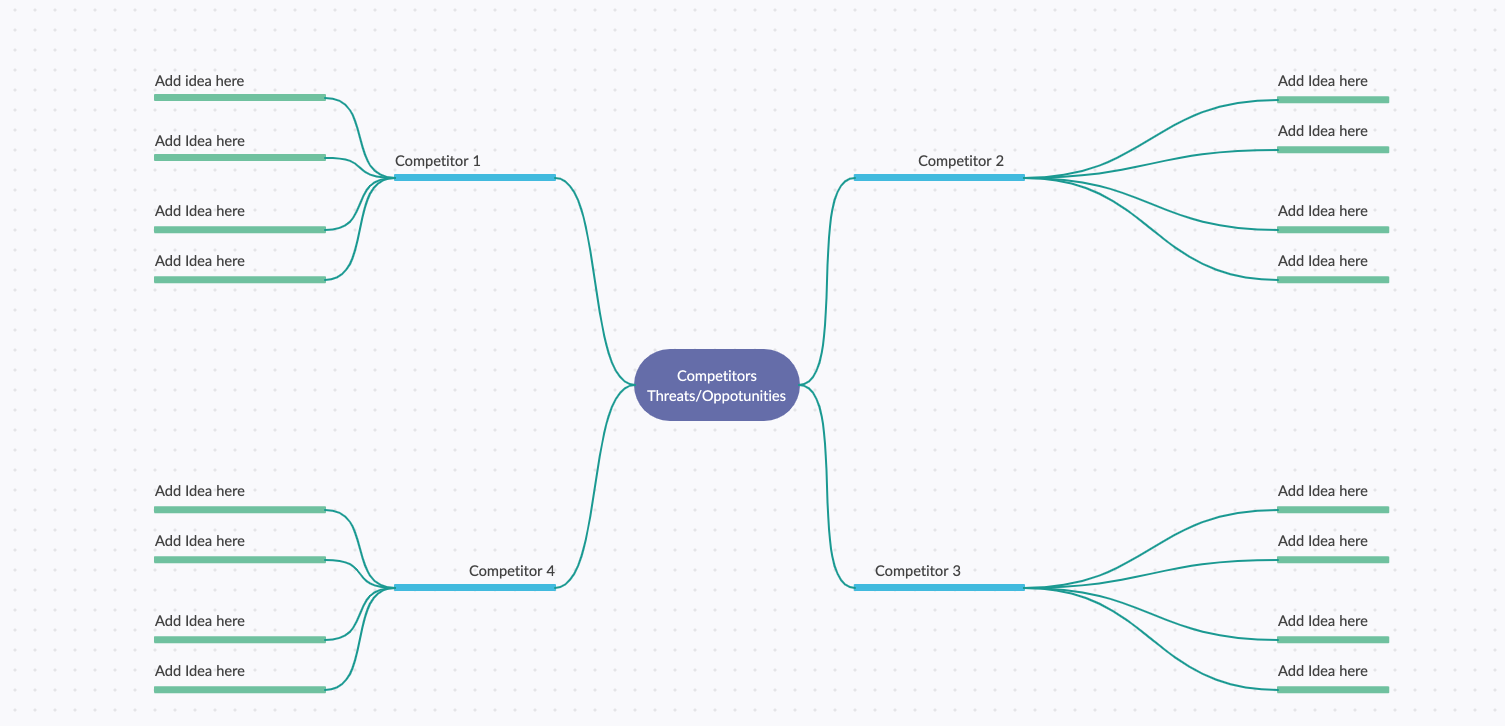
Miro also offers a suite of tools that allow for creative organization of data. For example, we created this SWOT analysis example using their software.
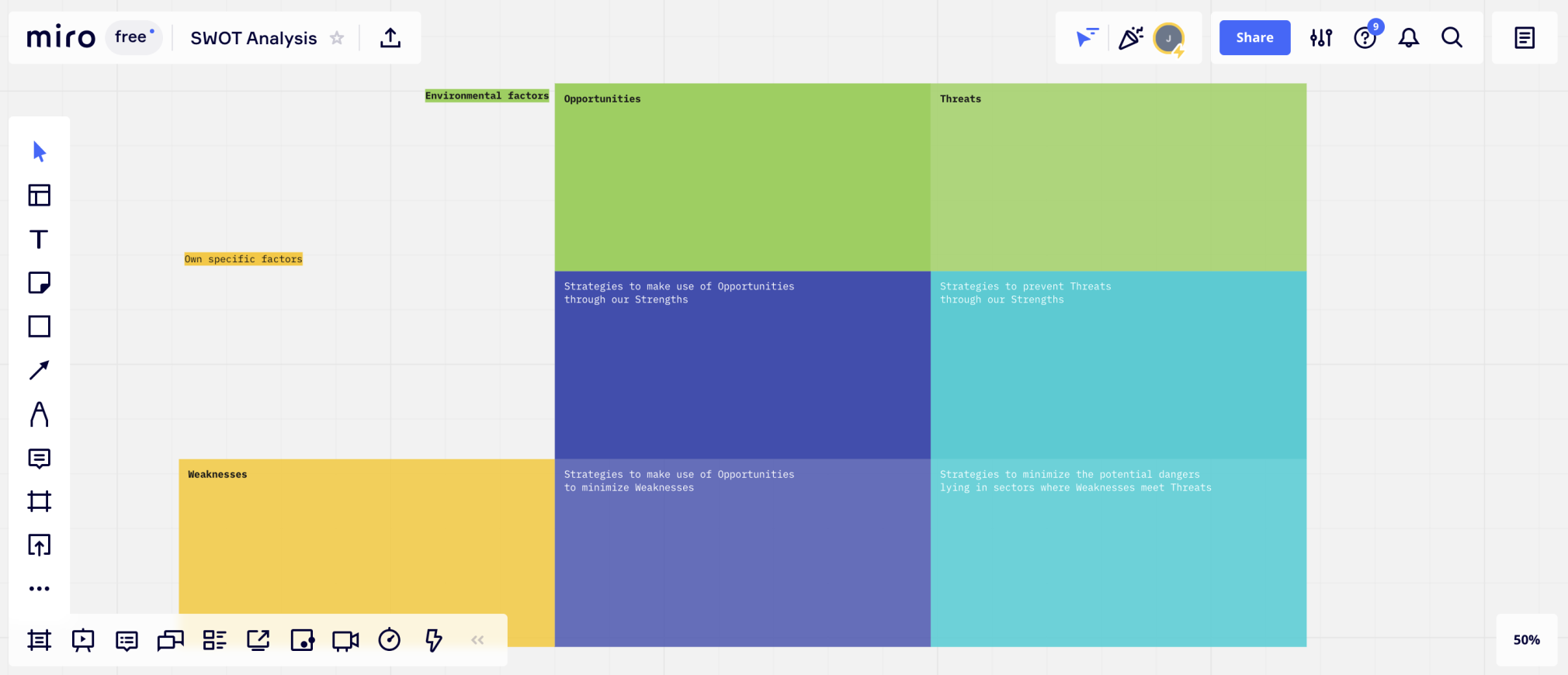
If you find yourself stuck trying to uncover insights from the data, try organizing it in different ways to spark inspiration.
Gather Data for Your Competitive Grid Using Semrush Tools
Now that we’ve covered a few different kinds of competitive grids, let’s take a look at how to gather some data. We’ll use Semrush’s .Trends tools to uncover data we might plug into a competitive matrix to reveal insights about our markets.
For this overview, we’ll look at:
Identifying your competitors Traffic data Social media strategy data Demographic data Geographic dataAs we examine different tools, keep an eye out for the “export” button in the upper right hand corner of some widgets. This butting allows you to export raw data that you can use to plug into your own competitive matrix if you’re looking to depict data differently than it’s presented in the Semrush tools.
Identifying your competitors
Before you can begin gathering competitive data, you need to identify your competitors. Semrush’s Market Explorer offers an easy way to automatically identify competitors surrounding a chosen domain.
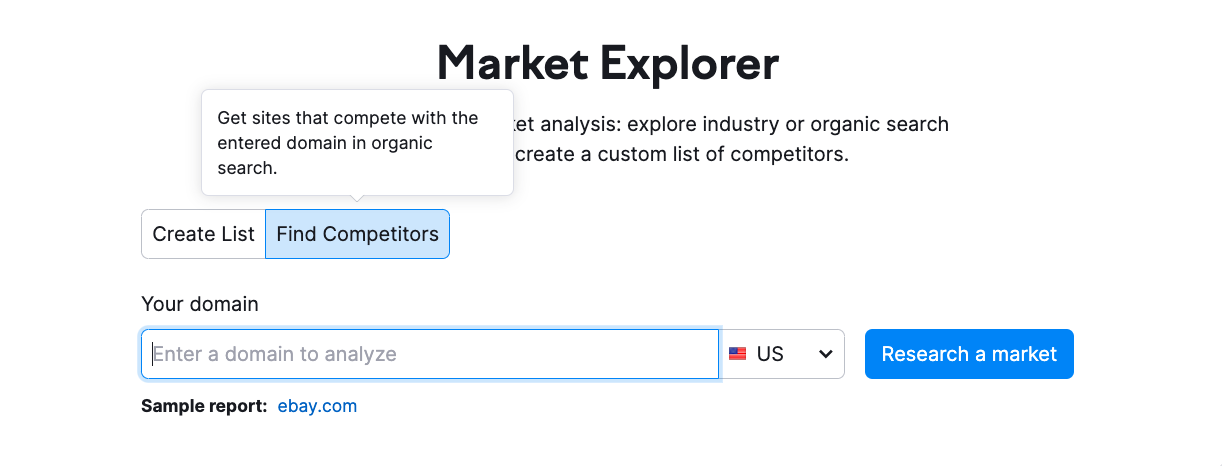
If you already have a good idea of who your competitors are, select the “Create List” tab. But if you’re unsure, you can select the “Find Competitors” tab. When you enter a domain in the search bar, the tool will automatically uncover the websites you compete with in terms of organic search.
As an example, we entered Discover.com to look at the financial services market. The tool then gathers high level information based on Discover.com’s top competitors.
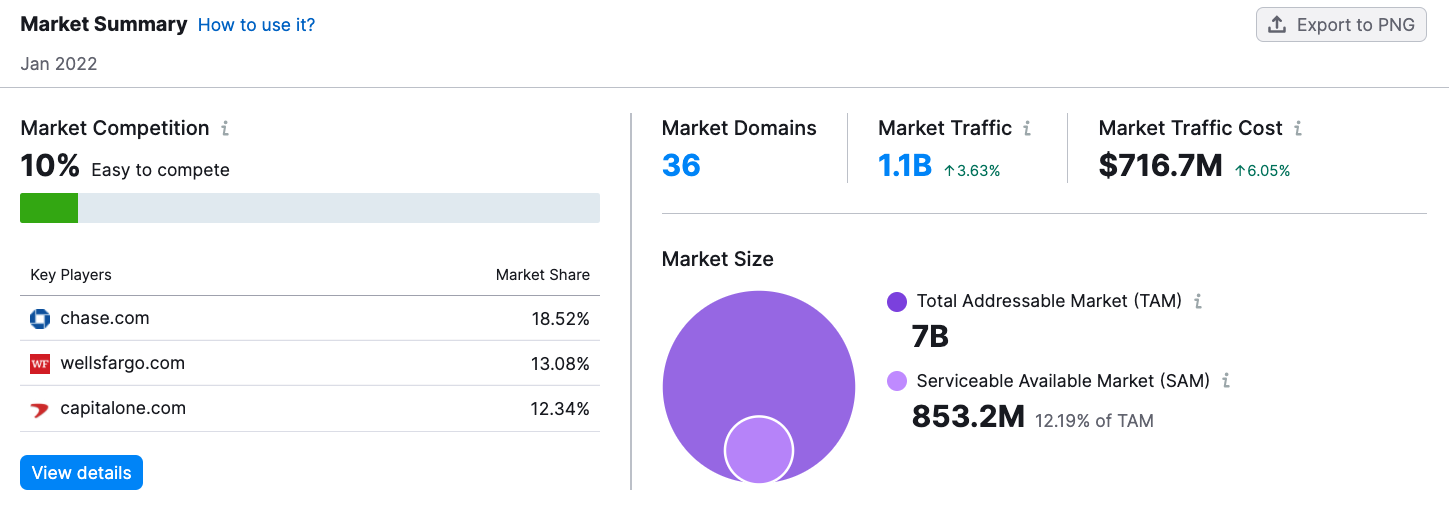
The overview provides high-level information about the target domain’s market share, the market’s total traffic, the level of competition, and the size of the market.
The market share data is particularly useful for comparisons on a competitive matrix. Placing this number alongside market share data for competitors could reveal a lot about a business’ position among competitors.
The overview report also includes Semrush’s Growth Quadrant. As mentioned above, this classic competitive matrix places competitors within one of four categories based on their website traffic and their traffic growth percentage.
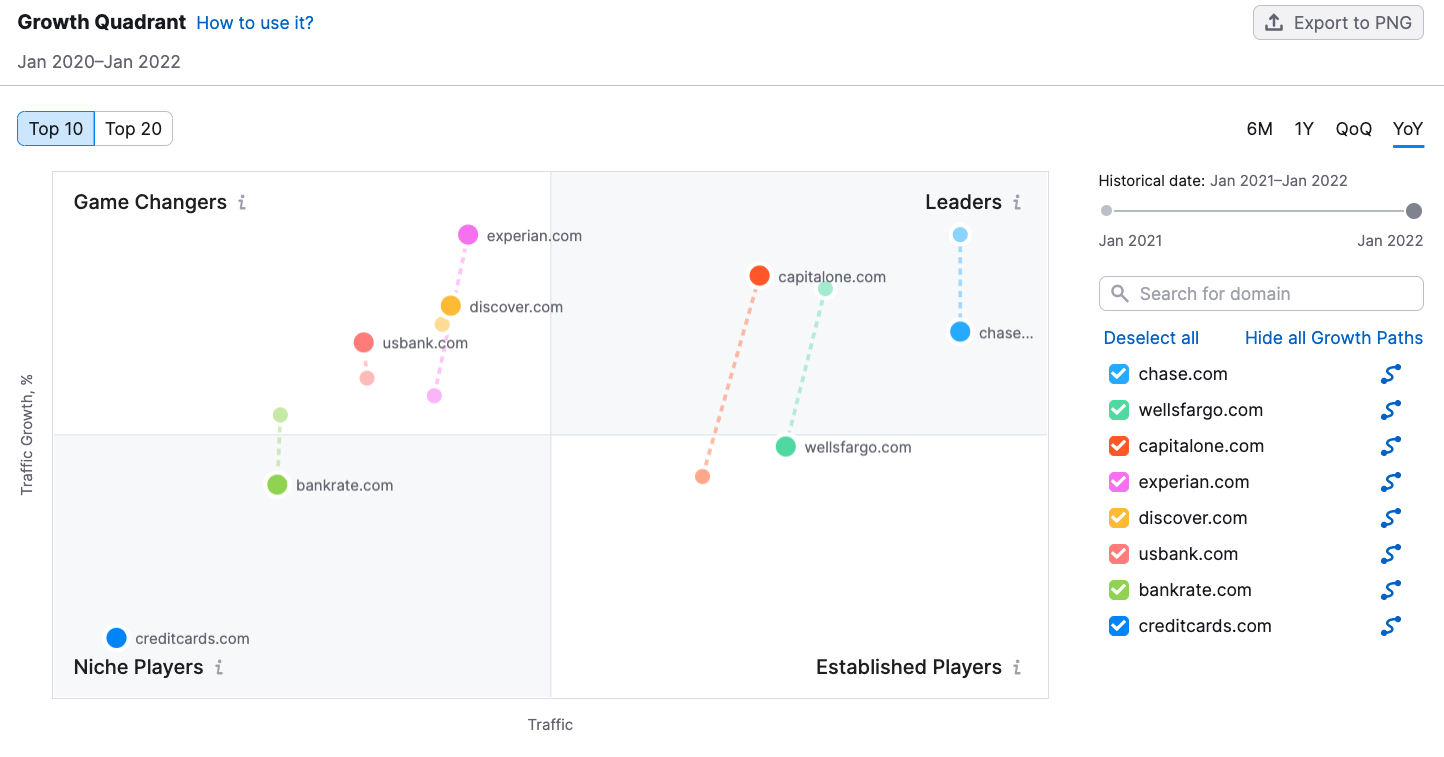
From this starting place, we can begin to dig deeper into our market and gather additional information about top market competitors.
Website Traffic Data
Semrush’s Traffic Analytics tool includes a variety of useful metrics for competitor websites based on petabytes of clickstream data. You can enter up to 5 domains and compare traffic statistics for visits, unique visitors, pages viewed per visit, visit duration, and bounce rate. You can also view historical data, view by location, or device type.
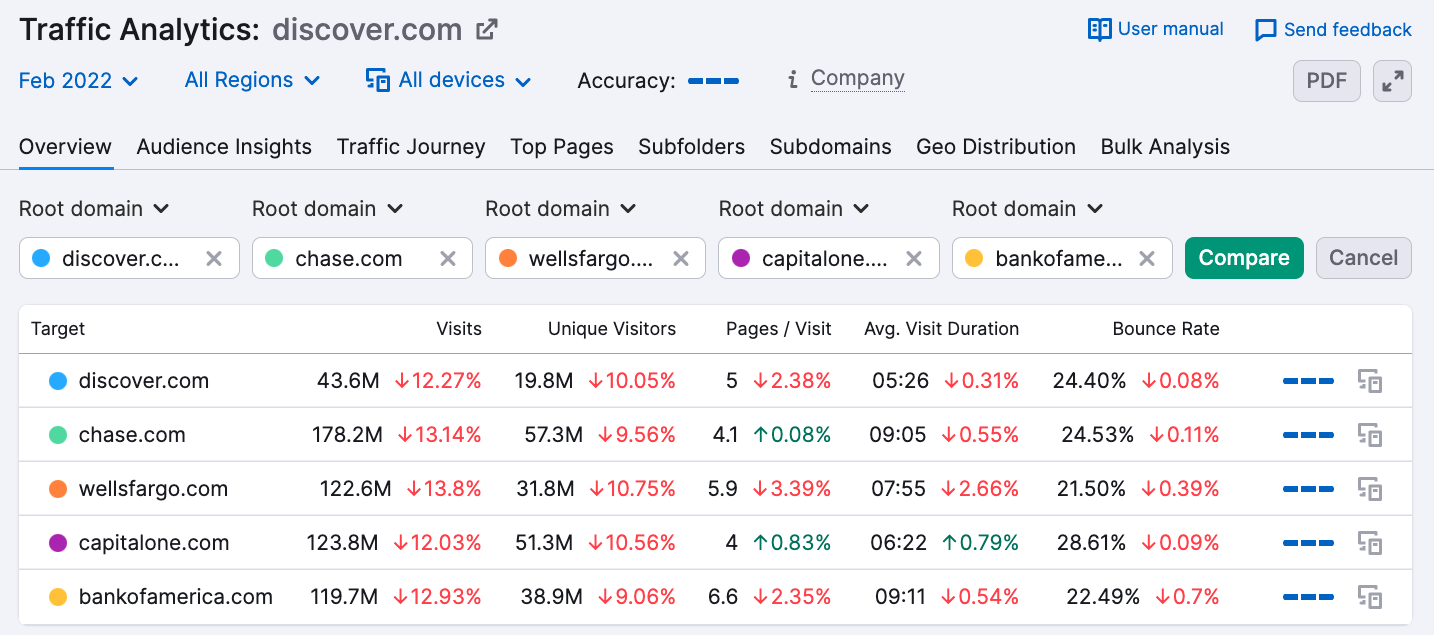
You can also view trends across time using the Trends by Competitors chart. This chart allows you to filter by category such as visits, unique visitors, or bounce rate. It also allows you to select various time frames. The image below shows monthly visits over the past year among 5 competitors.
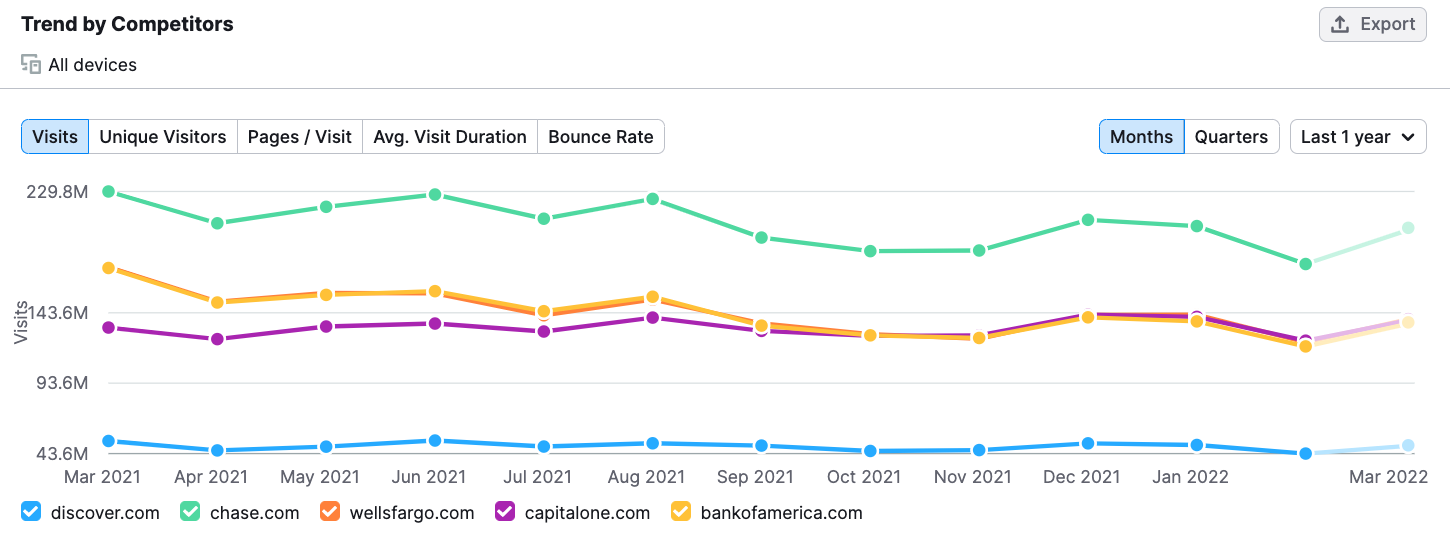
With Traffic Analytics you can also view a breakdown of traffic sources bringing people to your selected domains. Again, you can adjust the graph to show different time periods, locations, and device types. This graph shows a breakdown of traffic sources from all device types during October 2021.
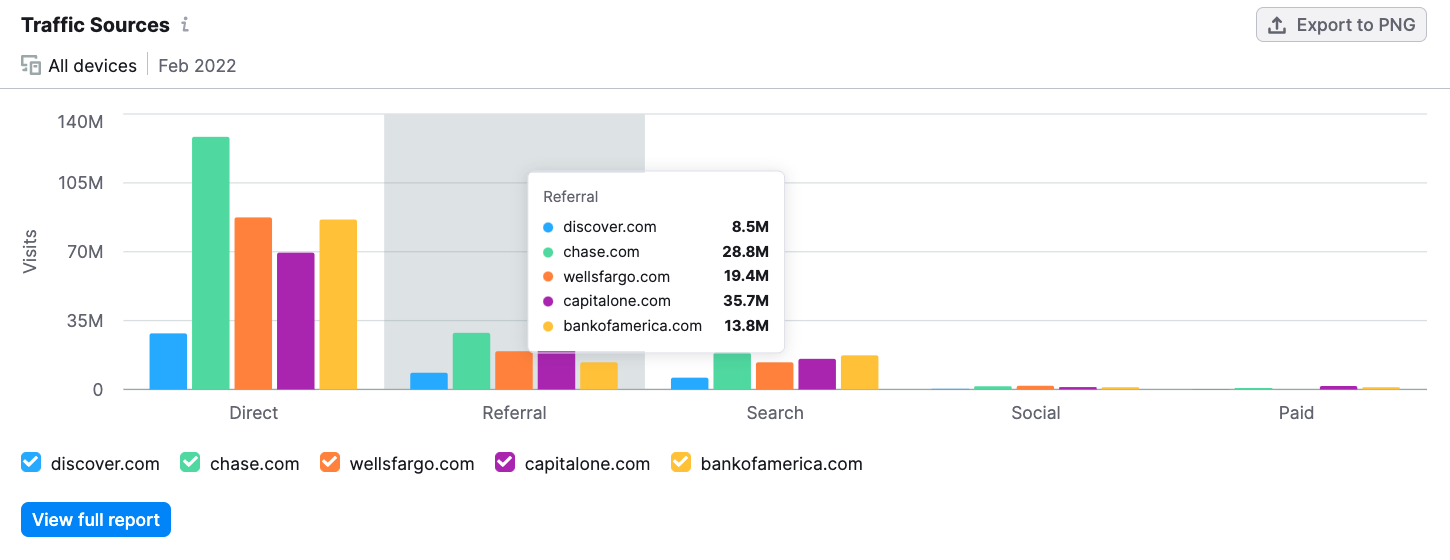
Between these three reports, you’ll uncover a wide variety of website traffic data that could be visualized and analyzed using your competitive matrix.
Social Media Strategy Data
For collecting social media strategy data about competitors, Semrush’s Market Explorer tool offers a few important kinds of data.
Beginning broadly, you could look at the Social Media Distribution Strategy graph in the Market Explorer tool’s Benchmarking report. The graph shows the breakdown of social media channels competitors used during the selected month compared to the total market.
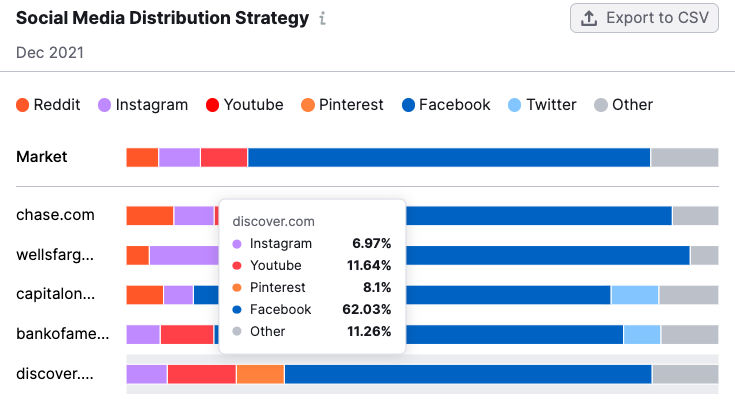
This graph can help you understand your competitors' social strategy, and benchmark your own strategy against it.
For more social media data, we can jump to the Demographics report. Here, you can use the Social Media Preferences graph to understand what networks customers in your market use most often.
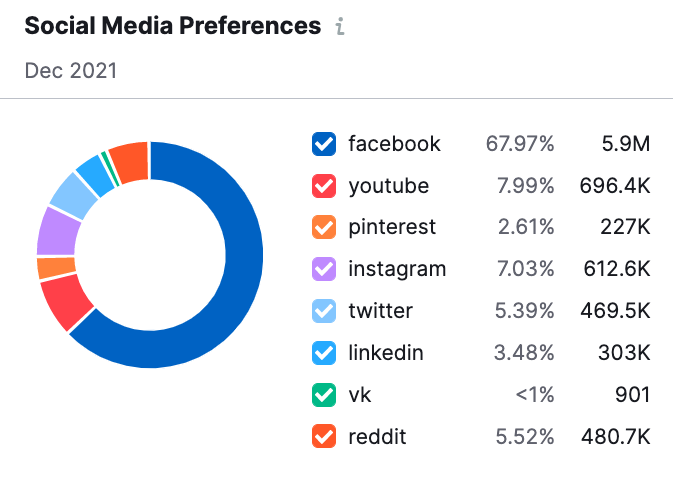
Comparing this graph across time periods or comparing this data with competitor social strategy data can reveal important information that can inform your own strategy.
Semrush’s Social Media Toolkit also has a Social Media Tracker tool that allows you to examine competitor activity on social media and benchmark against them. With this tool you can view metrics such as follower/subscriber numbers, posts/videos, and engagement for each of your competitors. Here are metrics for Chase.com for the last 30 days.
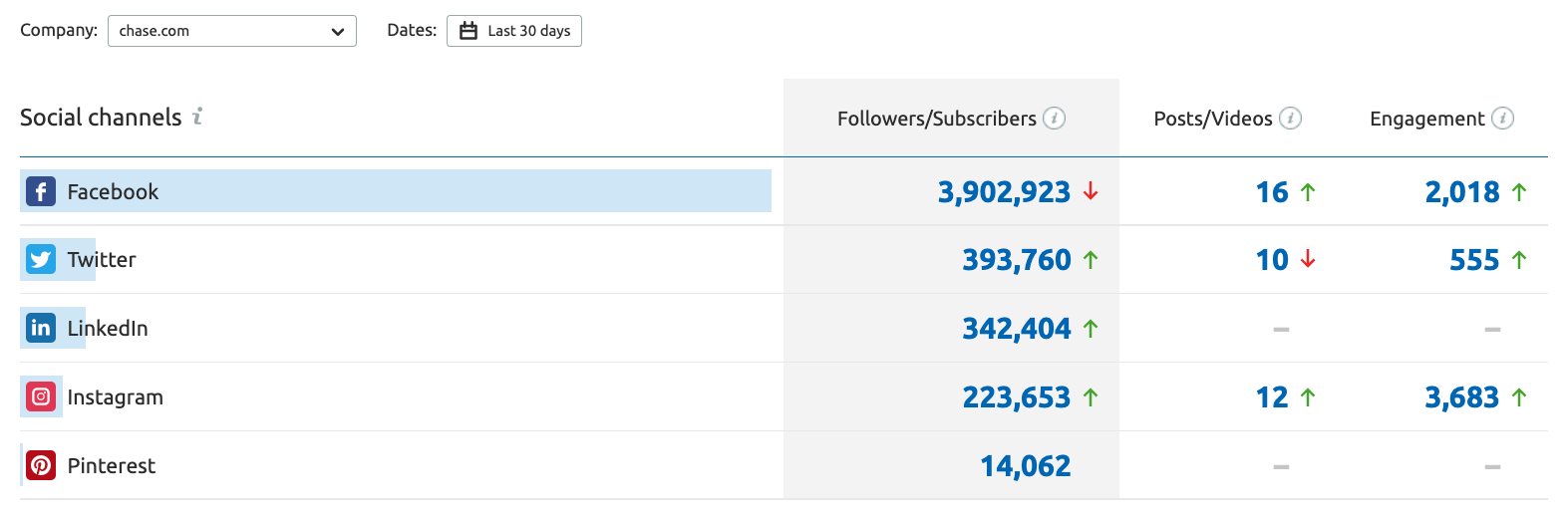
For a side-by-side comparison of social media data, you can look at the Comparison with Competitors widget. You can adjust the widget to show audience growth, competitor activity on social media platforms, or user engagement data.

Taken together, the Market Explorer tool and the Social Media Tracker provide a wealth of data you can gather and enter into your competitive matrix to better understand how your social media efforts shape up compared to the competition.
Demographics Data
Comparing demographics data using a competitive matrix can help develop insights about your audience that may inform your product offerings, communication plan, or marketing strategy. Again, Semrush’s Market Explorer tool can provide a wealth of data.
To view a comparison of demographics among competitors, you can view the benchmarking report. The Market vs. Selected Domains: Audience graph shows a side by side comparison of the audience among your selected domains.

Taking the data from these reports and organizing it in different ways using your competitive matrix can help you gain new insights about your audience.
Geographic Data
Geographic data is important for a variety of reasons. Often, you need to drill down into specific regions for a nuanced understanding of your market.
Maybe you’re trying to tailor your marketing campaigns to attract customers within a specific region. Or perhaps you’re considering entering new markets. In any of these situations, geographic data is key.
You can begin gathering geographic data with Semrush’s Market Explorer. The overview report includes a Market Geo Distribution chart that shows the distribution of traffic by country for your selected market domains, and the changes over the course of the selected month.
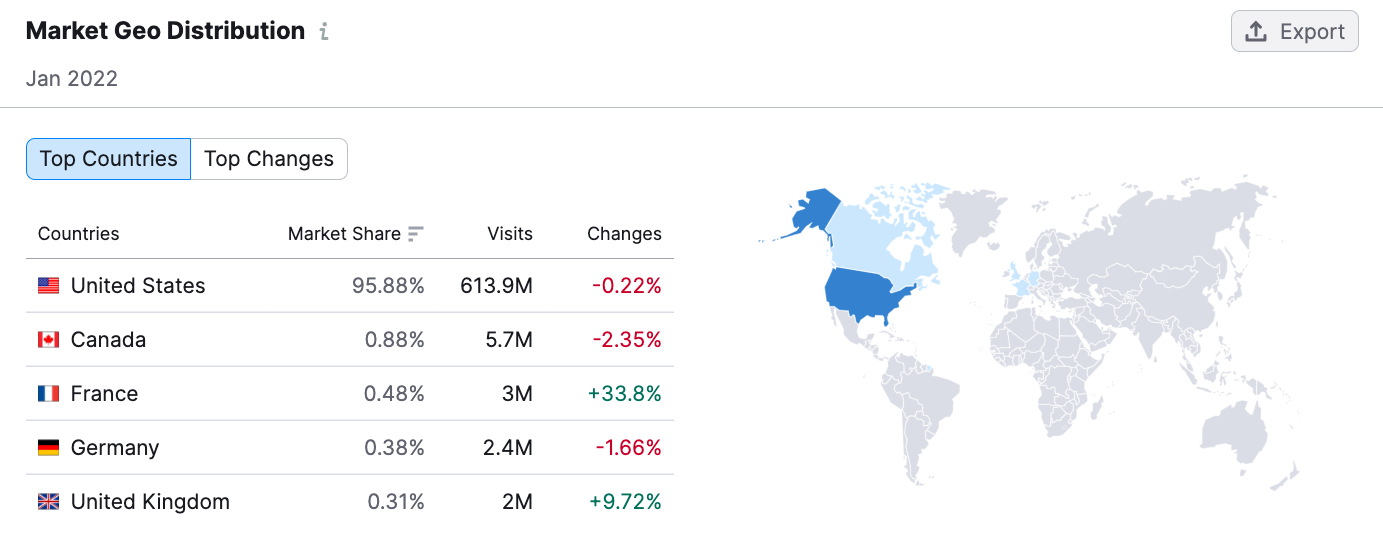
For more specific geographic data over a broader period of time for a single domain, you can turn to the Traffic Analytics Geo Distribution report. This graph shows traffic trends by country. You can select which countries you’d like to target and the time period you’d like to explore.
You can view more siloed data using the Traffic by Country chart. This chart shows a country’s total traffic share for each entered domain across the selected month.

With the data provided by these tools, you’ll be able to build competitive matrices that sheds light on the location-based aspects of your market and the differences between your business and competitors. With this information, you’ll be able to tailor your business strategy to meet the unique demands and challenges of specific geographic locations.
Key Competitive Matrix Takeaways
The true value of a competitive matrix lies in its ability to organize and visualize data in ways that allow for unique insights. While the shape, size, and data may change depending on the goal of your research, the concept of creating a competitive matrix remains the same: gaining a fresh perspective on data so it relays a true story about your market.
There will be some trial and error involved in constructing competitive matrices. Keep an open mind as you pull the data together, try putting data side by side in new ways, and never shy away from difficult questions.
Sometimes, you’ll come up empty handed. But if you continue looking for new angles to explore your data, you’re sure to come up with invaluable insights that will aid you in honing your business strategy and outcompeting your rivals.
Innovative SEO services
SEO is a patience game; no secret there. We`ll work with you to develop a Search strategy focused on producing increased traffic rankings in as early as 3-months.
A proven Allinclusive. SEO services for measuring, executing, and optimizing for Search Engine success. We say what we do and do what we say.
Our company as Semrush Agency Partner has designed a search engine optimization service that is both ethical and result-driven. We use the latest tools, strategies, and trends to help you move up in the search engines for the right keywords to get noticed by the right audience.
Today, you can schedule a Discovery call with us about your company needs.
Source:





